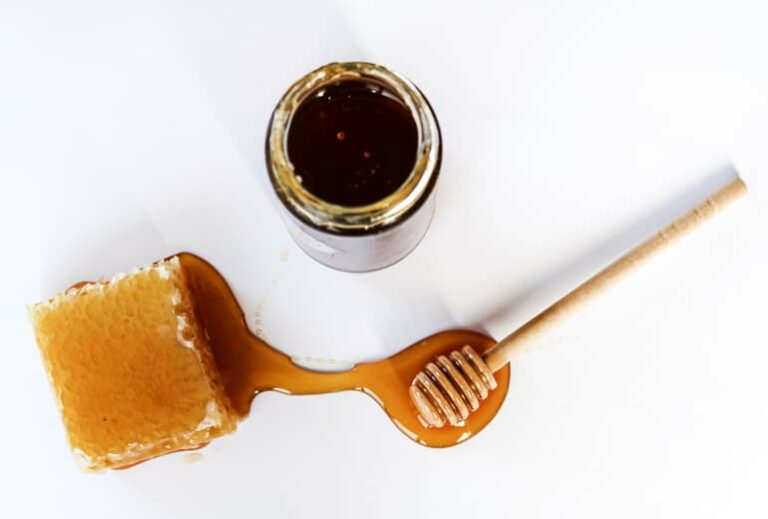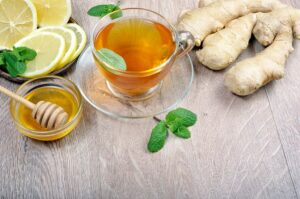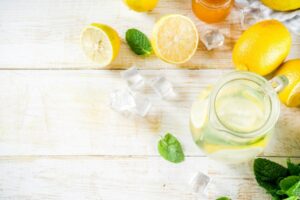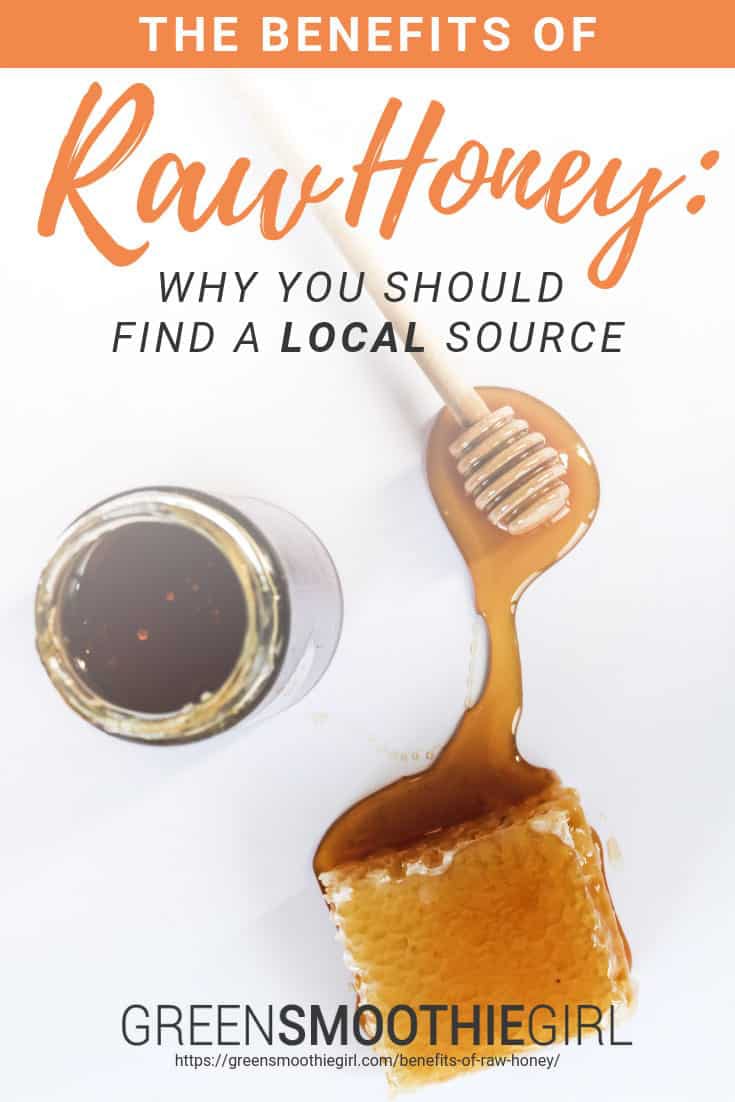The Incredible Benefits of Raw Honey: Immunity, Healing Wounds and Burns, and More

Sticky, sweet, and delicious, honey is a natural superfood that’s loaded with nutrients and minerals.
While it does have a high natural sugar content, the benefits of raw honey make it well worth stocking up on for your food storage and making it a minor part of your diet.
Research shows that raw honey is effective for treating burns, fighting colds, improving digestion, and much more.
In this post:
- What Is Raw Honey?
- What Kinds of Honey Are Not Raw?
- What Are The Dietary Benefits Of Raw Honey?
- How Can Raw Honey Be Used As A Remedy?
- Which Kind Of Honey Is Best To Buy?
- How Long Does Raw Honey Keep, and How Should I Store Them?
- How To Use Honey For Better Health
Research shows that raw honey is effective to treat burns, fight colds, improve digestion, and so much more.
What Is Raw Honey?
According to the USDA National Honey Board, there’s no legal standard for what qualifies as raw honey, but the Board itself offers this definition of raw honey: “honey as it exists in the beehive or as obtained by extraction, settling or straining without adding heat.”
In general, most people consider any honey that hasn’t been heated or filtered to be raw honey.
What Kinds of Honey Are Not Raw?
Honey distributors put the raw product through varying degrees of filtering and processing, each removing or destroying some beneficial components of the product.
Filtration
Since honey is created by honey bees that fly from plant to plant, pollen from the plants’ stamens can get into the honey as an incidental part of the process. Processed honey is filtered to remove that pollen – along with other fine particles, air, and other natural substances that may have gotten suspended in honey.
Filtration gives filtered honey a consumer-friendly clear and bright appearance, and it also can help to delay crystallization, keeping the honey in a liquid state for longer periods of time.
Pasteurization
Along with being filtered, much of the processed honey sold in supermarkets is pasteurized, which means it’s been heated between 145 to 150 degrees for 30 minutes. The heat is used to kill bacteria and yeast, remove crystals, improve the color and texture, and give honey a longer shelf life. However, the process of pasteurization kills many of the beneficial nutrients in honey.
Dilution/Adulteration
In addition to being filtered and pasteurized, much of the processed honey sold in grocery stores is often cut with other substances – like high-fructose corn syrup. This “stretches” the honey farther, so you get more volume, but it’s an inferior and impure product.
Ultrafiltration
Some honey also undergoes a process called ultrafiltration, which is different than standard filtering processes. In ultrafiltration, water is added to the honey, and the mixture is filtered under high pressure, and then the water is removed. The result is a colorless product that’s used as a sweetener. In the U.S., this highly processed product can be labeled “derived from honey,” but it’s not legally considered to be honey.
Because of all these variations and loss of nutrients in processed honey, purchasing raw honey is your best benefit to ensure you’re getting a pure product that still includes all of its natural nutrients.
Raw honey may look cloudy because of the suspended pollen or air bubbles, but regardless of its appearance, it’s safe to consume.
Note: There is a risk that raw honey can contain the bacteria that cause botulism poisoning for babies, so medical experts say that infants less than one-year-old should not eat raw honey.
What Are The Dietary Benefits Of Raw Honey?
Research shows that the wide-ranging benefits of honey apply specifically to raw honey that’s both unfiltered and unpasteurized.
If you’re using honey as a remedy or to boost your diet, be sure to look for raw, organic honey to ensure you get the full scope of benefits.
When it comes to the dietary benefits of honey, there are many:
- Honey is loaded with phytonutrients – which are compounds that help protect plants from harm. Phytonutrients in raw honey have been shown to prevent cancer and tumors.1
- Phytonutrients in raw honey also are responsible for the high levels of antioxidants found in raw honey.2 These antioxidants fight free radicals, which can cause cancer and heart disease and contribute to aging.
- Other antioxidants known as polyphenols found in raw honey can help reduce the risk of heart disease.3
- Honey is an excellent antibacterial remedy. The enzymes in honey naturally produce hydrogen peroxide,4 which is antiseptic, and that creates a barrier in wounds and burns that can prevent infection.
- As an antifungal, raw honey also has been proven to fight fungus – including Candida, 5 which causes yeast infections.
- A recent metastudy on 42 years of honey research found that honey can be an effective immune system boost and anti-inflammatory, studied as an effective treatment for everything from diabetes to gastrointestinal diseases, respiratory issues like asthma, and more.6
How Can Raw Honey Be Used As A Remedy?
Honey has been used as a natural remedy for thousands of years, and research is finally proving what “old wives” have known about honey all along. These are some of the research-tested ways honey can be used as a remedy:

Wounds and Burns
The enzymes in honey naturally produce hydrogen peroxide,4 which is antiseptic. That means honey is an excellent antibacterial and antifungal treatment that can help heal wounds. Therapeutic honey can be used to reduce infection and promote healing in burns, ulcers, and cuts,7 and it also helps to prevent bacteria and fungi8 that can contaminate and infect wounds.
Studies on honey for burns confirm my own experience healing nearly painlessly and without scarring from a 3rd degree burn in a friend’s kitchen, when boiling gravy splashed all over my arm. A 2011 review showed data supporting “the healing properties of honey include stimulation of tissue growth and minimized scar formation.”9
Even the FDA has gotten on board, approving Medihoney10 – which is Manuka honey made from the nectar of Leptospermum scaparium in New Zealand – for the treatment of wounds and burns. This medical-grade honey has been irradiated to sterilize it, however, and while it’s technically still considered raw, I’m not interested in honey-in-a-tube when I can get the real thing, with all its properties intact.
Sore Throats, Coughing, and Colds
Raw honey also can be effectively used to soothe sore throats, coughs, and colds.
Researchers found that a dose of honey was more effective at treating coughing than standard cold medicine,11 and honey as a treatment for sore throats and stuffy noses also was shown to be highly effective.12
Digestion
There also are scientific studies that show honey can be used to treat tummy troubles. Because honey is a prebiotic, it promotes healthy bacteria in the intestines13 – which can improve digestion and overall health.
Ulcers
Raw honey can be used against Helicobacterpylori,14 which is the bacteria that causes peptic ulcers.
Honey And Seasonal Allergies
The idea behind honey treating allergies is that when a person eats local raw honey, they can also be ingesting small amounts of local pollen. Over time, a person may become less sensitive to this pollen. As a result, they may experience fewer seasonal allergy symptoms.
Evidence for this benefit of raw honey is anecdotal, but my family stopped experiencing seasonal allergies after a couple of years of eating local raw honey daily.
Which Kind Of Honey Is Best To Buy?
If you’re purchasing honey for health benefits or want honey to use as a home remedy, look for organic, raw honey (we have the freshest, high-quality, organic, raw honey available during our Group Buy.)
Other honeys have been filtered, heated, or pasteurized, removing many of the nutrients and beneficial healing properties.

Plus, products that aren’t labeled “raw honey” may be cut with other substances, like high fructose corn syrup.
Remember – while processed honey will probably look bright and clear, raw honey may look cloudy because of the suspended pollen or air bubbles. It also may have started to crystallize, but warming it slightly (taking care not to heat it) should help it regain its liquid form. Avoid heating it on the stove, and instead, put a bucket or jar of crystallized honey in a container of hot tap water.
How Long Does Raw Honey Keep, and How Should I Store It?
Honey is the most naturally stable food you can buy, thanks to the high amount of sugars. It literally NEVER goes bad.
Though it doesn’t spoil, you should still store it properly to preserve its taste and texture. You don’t want to keep honey in the refrigerator. Storing in your pantry or long-term food storage is a great idea. Keep it in glass jars in a cool location away from direct sunlight.
Be sure not to introduce moisture to your stored honey. Use a dry spoon because even a small amount of water can cause it to ferment.
Crystallized, or cloudy, honey that’s “turned to sugar” is not bad; you can still eat it. If that happens, here’s how to re-liquify it: place a jar with honey in a pan of hot water (not boiling) and stir while gently heating it. Be careful not to overheat it.
How To Use Honey For Better Health
Of course, to reap all the health benefits of raw honey, you’ll need to consume it!
Since honey is delicious, it’s easy to add it to your tea, drizzle a little over cooked whole oats, mix it with almond butter for a sandwich filling or celery boats, or even enjoy it by the spoonful – in moderation, of course.
You also can use it as a dip for fruit or swirl it into your yogurt – but try to avoid heating it for best results.
To help you get started using honey for better health, I’ve got some great honey recipes that are easy to make—my favorite is a Turkish candy, with only 3 ingredients!
To get these recipes in a printable download, just click here. Then, whip up one of the heavenly honey delights, and start enjoying the health benefits of raw honey today!
RAW HONEY RECIPE #1: Halvah Candy
INGREDIENTS
- ½ cup raw honey
- 1 cup raw tahini (sesame paste)
- ½ cup white and/or black sesame seeds
DIRECTIONS:
- Stir the honey and tahini together well.
- Roll the mixture into small balls.
- Roll the balls in the sesame seeds.
- Refrigerate or freeze.
RAW HONEY RECIPE #2: Honey Dressing
INGREDIENTS
- ¾ cup extra virgin olive oil
- ½ cup raw honey
- 1 cup fresh lemon juice
- ½ tsp. sea salt
DIRECTIONS
- Blend all ingredients in a high-powered blender until smooth. Makes 2 ¼ cups.
- Store in the refrigerator for up to 2 weeks or in the freezer indefinitely.

RAW HONEY RECIPE #3: Honey Lemonade
INGREDIENTS
- 1/3 to 1/2 cup raw honey
- 1½ cups warm water
- 1 cup raw, fresh-squeezed lemon juice
DIRECTIONS
- Blend all the ingredients together.
- Refrigerate until cold.
- Pour into pretty glasses full of ice to serve.
- Tip: Make it a potent anti-bacterial for when you have a cold or infection, by adding cayenne, ginger, turmeric, and apple cider vinegar!
RAW HONEY RECIPE #4: Honey Mustard Vinaigrette
INGREDIENTS
- ¼ cup fresh lemon juice
- 2 Tbsp white wine vinegar
- 2 Tbsp raw honey
- 2 Tbsp brown mustard
- ½ cup extra virgin olive oil
- ¼ cup unrefined flaxseed oil
- 3 cloves garlic
- Pinch of sea salt
- Freshly ground black pepper to taste
- 1 tsp. cayenne
- 2 tsp water (to achieve desired consistency)
- 1 Tbsp whole mustard seeds
DIRECTIONS
- Soak the whole mustard seeds in 2 Tbsp of water for 30 minutes.\
- Blend all ingredients in a high-powered blender until smooth. Makes scant 2 cups.
- To get these recipes in a printable download, just click here.
[Read Next: Natural Treatments for Urinary Tract Infections (UTI)]

Disclosure: This post may contain affiliate links that help support the GSG mission without costing you extra. I recommend only companies and products that I use myself.

Resources
- WLO Jimoh, UA Ummi. (2014). Chemical characteristic of selected imported and local honey sold around Kano metropolis, Nigeria. Bayero Journal of Pure and Applied Sciences. 2014;7(2).
- Cardetti et al. (2003 Feb 11). Honey with High Levels of Antioxidants Can Provide Protection to Healthy Human Subjects. Journal of Agricultural and Food Chemistry. 2003;51(6):1732-1735.
- Khalil, M I. Sulaiman, S A. (2010 Jul 3). The potential role of honey and its polyphenols in preventing heart diseases: a review. African Journal of Traditional, Complementary and Alternative Medicines: AJTCAM. 2010;7(4):315-21.
- Mandal, Manisha Deb. Mandal, Shyamapada. (2011 Apr). Honey: its medicinal property and antibacterial activity. Asian Pacific Journal of Tropical Biomedicine. 2011;1(2):154-60.
- Abdelkader, Benhalima. Abdelmelek, Meslem. Moussa, Ahmed. Noureddine, Djebli. Saad, Aissat. (2012 Jul). Antifungal activity of four honeys of different types from Algeria against pathogenic yeast: Candida albicans and Rhodotorula sp. Asian Pacific Journal of Tropical Biomedicine. 2012;2(7):554-7.
- Farkhondeh, Tahereh. Samarghandian, Saeed. Samini, Fariborz. (2017 Apr-Jun). Honey and Health: A Review of Recent Clinical Research. Pharmacognosy Research. 2017;9(2):121-127.
- Coombes, A B. Lusby, P E. Wilkinson, J M. (2002 Nov). Honey: A Potent Agent for Wound Healing? Journal of Wound, Ostomy and Continence Nursing. 2002; 29(6):295-300.
- Molan, Peter Charles. (2001 Dec). Honey as a topical antibacterial agent for treatment of infected wounds. World Wide Wounds. 2011.
- Al-Ghamdi, Ahmad. Al-Waili, Noori. Salon, Khelod. (2011 Apr 5). Honey for wound healing, ulcers, and burns; data supporting its use in clinical practice. Scientific World Journal. 2011;11:766-787.
- (2001 Aug 2). FDA clears Derma Sciences' MEDIHONEY Hydrogel Wound and Burn Dressing. News: Medical Life Sciences. 2011.
- Mozaffari-Khosravi, Hassan. Mozayan, Mohammad Reza. Shadkam, Mahmood Noori. (2010 Jul 20). A Comparison of the Effect of Honey, Dextromethorphan, and Diphenhydramine on Nightly Cough and Sleep Quality in Children and Their Parents. The Journal of Alternative and Complementary Medicine. 2010;16(7).
- Siti Amrah Sulaiman1 , et al. (2011). The Benefit of Tualang Honey in Reducing Acute Respiratory Symptoms Among Malaysian Hajj Pilgrims: A Preliminary Study. Journal of ApiProduct and ApiMedical Science. 2011;3(1):38-44.
- Gandhi, H. Kajiwara, S. Ustunol, Z. (2002 Jan 1). Effect of Honey on the Growth of and Acid Production by Human Intestinal Bifidobacterium spp.: An In Vitro Comparison with Commercial Oligosaccharides and Inulin. Journal of Food Protection. 2002;65(15):214-218.
- Graham, David Y. Osata, Michael S. Reddy, Siddharta G. (1999 Mar). Osmotic Effect of Honey on Growth and Viability of Helicobacterpylori. Digestive Diseases and Sciences. 1999;44:462-262.
Posted in: 12 Steps To Whole Food, Eco Friendly Living, Reviews













